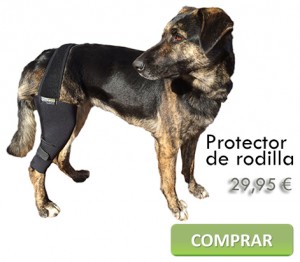Orthopedic aids for dogs


New technical and orthopedic aids for dogs are used in a wide variety of cases. These increase the mobility of dogs by providing the necessary support to maintain daily activity. Dogs need to exercise to maintain their physical and emotional well-being. If a dog is unable to exercise, it can develop problems such as heart disease, obesity, bone alterations, muscle atrophy, and emotional problems such as aggression or anxiety.
Applicable cases
Technical aids can be used for sprains, muscle weakness, arthritis, hip dysplasia, post-operative rehabilitation, lameness, weakness or pain in the joints that end up generating a mobility problem. The technical aids should allow the dog to perform its daily activities, but they should also be comfortable and offer protection against irritations and ulcers on the dog’s skin so it is important that they are performed by specialists. We list the most frequent:
Knee
Knee protectors are typically used after surgery for rehabilitation of the anterior cruciate ligament (ACL), patella dislocation, medial collateral ligament (MCL), lateral collateral ligament (LCL), or posterior cruciate ligaments (PCL). Knee pads provide support and stability, prevent muscle loss during the recovery period, and reduce the risk of further injury. Knee protectors are also often used in cases where surgery is not performed.
Tarsus and Carpus
Tarsal protectors are indicated in cases of osteoarthritis but also for post-surgical rehabilitation or injury to the Achilles tendon, nerve damage to the hind limb or foot and rehabilitation of the hock joint. They can also be used as long-term support in non-surgical conditions. A tarsus or hock protector stabilizes the bone of the back leg, as well as the muscles and tendons of the limb and knee. It works similarly to a knee brace in humans, allowing the dog to move without straining the joint. It also prevents the dog from re-injuring the affected joint or ligaments.
Elbows
An elbow protector is used to support the elbow joint after surgery or to reduce pain from arthritis, degenerative joint diseases, or other similar conditions. It provides control in lateral movement while allowing for normal extension and flexion while treating and protecting hygromas and calluses.
A hip support holds and increases the temperature of the dog’s lower back and hip. Made of special neoprene, it surrounds the lower back, hip and upper leg and is fastened thanks to a Roman-type harness. Hip supports are commonly used for dogs with mild to moderate hip dysplasia and localized osteoarthritis.
Shoulders
Medial shoulder instability (MSI) is one of the causes of lameness in the front legs. A special support would allow the shoulder to be supported, which would limit the extension, flexion and abduction, allowing the dog to support its weight. These aids can be used after surgery or as a non-surgical treatment but also preventively.
Recent Posts
What side effects do anti-inflammatories have in dogs?
Anti-inflammatory drugs, called NSAIDs (nonsteroidal anti-inflammatory drugs), are the most commonly prescribed pain reliever in…
Exercises to strengthen the dog’s hind legs
Improving the muscles of the hind limbs in dogs is an interesting option both in…
What to do with a dog that has back problems
Dogs can have health problems related to their limbs. But they can also have back…
Total or partial rupture of cruciate ligament in dogs
One of the most frequent injuries that dogs usually suffer is the rupture of one…
Solutions to hip dysplasia in dogs
Hip dysplasia in dogs is one of their most common inherited bone diseases. It is…
How to treat patellar luxation in dogs?
There is talk of patellar dislocation in dogs, when the patella, a small bone located…
